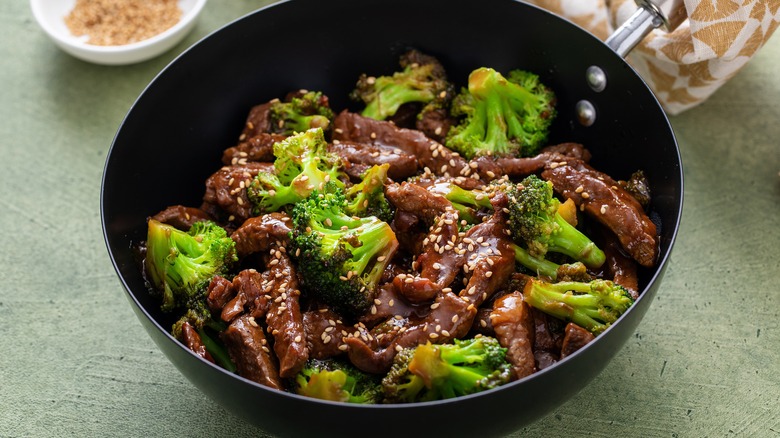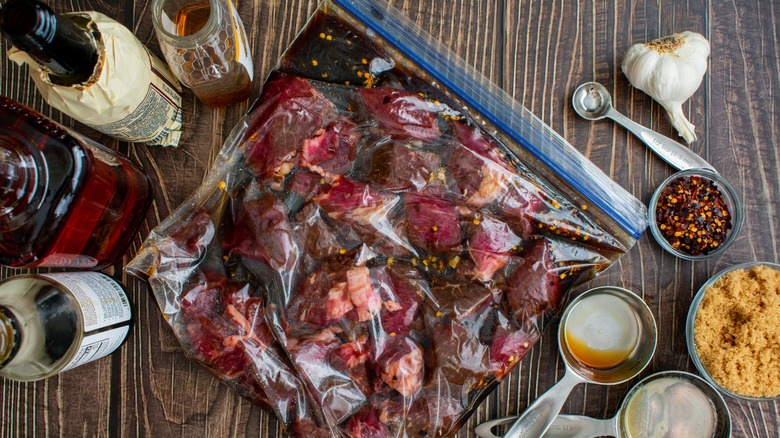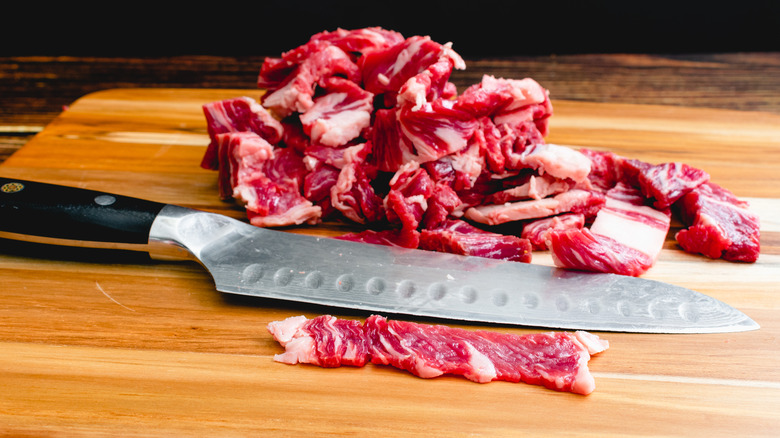The Controversial, But Crucial Step You Need To Know For Better Stir-Fries
Although it adds prep time to this otherwise quick cooking meal, there's a better way to make stir-fries that starts with washing (really soaking and squeezing) the meat. A technique commonly used by Sichuan chefs, this crucial step is controversial, given that the United States Department of Agriculture (USDA) advises against washing meat or poultry since the practice increases the risk of cross-contamination. If surfaces are not appropriately cleaned afterward, the bacteria in raw meat can be transferred to other food and kitchen surfaces, causing foodborne illnesses. So, please vow to be responsible and carry on.
The reason for washing meat in stir-fries differs from when the practice was widely used decades ago. At one point, rinsing the meat was a necessity since it was 'dirty' when you brought it home — or you had butchered the meat yourself. Meat processed today is cleaned before it reaches consumers. The technique is now used to tenderize beef and to extract water from inside the protein, allowing more marinade to absorb.
Sliced beef is massaged in a bowl of water for a minute or two, releasing some of the meat's natural juices. It's then drained in a fine mesh strainer and aggressively squeezed, removing all the water from the protein. This prevents diluting your marinade, and you will notice an immediate change in the beef's color and texture. Before building your marinade, make sure you properly wash your hands and the sink with soap and hot water.
How to build marinades
You can easily make a marinade using a few pantry ingredients, roughly needing ½ cup per pound of meat. Marinades flavor the meat's surface and improve the texture of lean, tougher cuts. They traditionally contain oil, an acid (like vinegar or citrus), and seasoning. The solution typically includes salty elements like soy or Worcestershire sauce and spices, herbs, or aromatics (onions, garlic, or ginger). Stir-fry marinades, unlike ones you'd use for grilled chicken, often include two more critical ingredients: cornstarch and baking soda.
Cornstarch coats the meat, absorbing the juices released during cooking to keep the beef tender. Baking soda is alkaline and used to 'velvet' the meat, tenderizing tough protein. Similarly, egg whites can be used. Oil is included to prevent the meat from sticking to the pan as it cooks. Consider the oil's flavor and smoking point when deciding which type to add. Soybean, vegetable, and canola oil are neutral tasting and have a high smoking point while peanut and coconut oil will impart subtle flavor.
Salt adds umami and helps the meat retain moisture as it cooks over high heat. Acids are on the other end of the pH scale from alkaline but are similarly used to soften the meat by breaking down some of the protein's tough muscle fibers. Some vinegars have high sugar levels, which also helps with caramelization and adds depth. You can reduce waste by using leftover wine for a quick marinade, adding acid, sugar, and aromatics to the marinade.
Tips for making better stir-fries
Stir-fry is a versatile dish that broadly describes a Chinese style of wok cooking that uses high heat to cook food quickly. When including a protein, it's important to select the proper cut to achieve the best results. To prepare dishes like Hunan-style beef stir-fry, purchase a lean cut of beef with coarse grain to absorb the flavorful marinade. Although your butcher may use different names, flank, skirt, flap, hanger, or flat iron steak are good budget-friendly options.
To ensure your protein stays tender, cut it into bite-sized pieces against the grain. A good trick to make thinner slices is to freeze the beef for 15 minutes before slicing it. Place the frozen meat on a cutting board and locate the muscle fibers that run the length of the cut, which is the grain. Cut thin slices across the grain to shorten the muscle fibers. You can also try slicing on the bias to increase the surface area of each slice, resulting in more sauce on every bite.
Similar to washing the beef, massage the marinade into the meat, helping tenderize it. Cover the beef and marinate it for several hours, up to one day, in the fridge before cooking. Although there's some debate on whether woks are better for stir-frying, a large skillet can be used. Cook the meat, then your veggies, adding the most tender type last. Finish the dish with a sauce, creating a velvety coating on the stir-fry.



